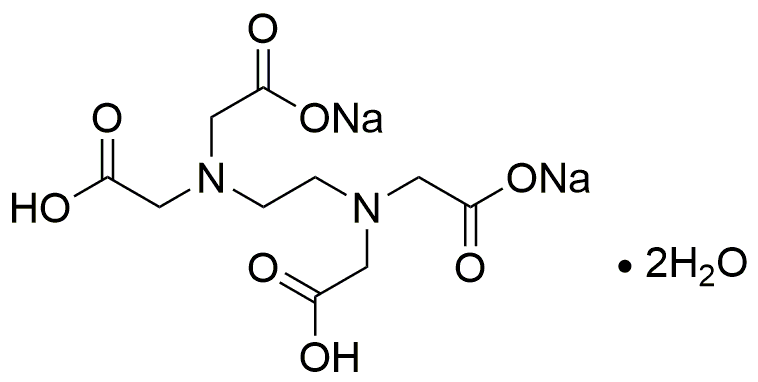Ethylenediaminetetraacetic acid disodium salt, dihydrate is widely utilized in research focused on:
- Metal Ion Chelation: This compound effectively binds to metal ions, making it valuable in industries such as water treatment and pharmaceuticals, where controlling metal ion concentrations is crucial.
- Food Preservation: It is used as a food additive to prevent spoilage by chelating trace metals that can catalyze oxidation, thus extending shelf life and maintaining quality.
- Biomedical Applications: In medicine, it is employed in diagnostic imaging as a contrast agent, enhancing the visibility of organs and tissues during imaging procedures.
- Laboratory Reagents: Researchers use it in biochemical assays to study enzyme activity and metal ion interactions, providing insights into various biological processes.
- Cosmetic Formulations: The compound is included in skincare products to stabilize formulations and improve product efficacy by preventing metal-induced degradation.
General Information
Properties
Safety and Regulations
Applications
Ethylenediaminetetraacetic acid disodium salt, dihydrate is widely utilized in research focused on:
- Metal Ion Chelation: This compound effectively binds to metal ions, making it valuable in industries such as water treatment and pharmaceuticals, where controlling metal ion concentrations is crucial.
- Food Preservation: It is used as a food additive to prevent spoilage by chelating trace metals that can catalyze oxidation, thus extending shelf life and maintaining quality.
- Biomedical Applications: In medicine, it is employed in diagnostic imaging as a contrast agent, enhancing the visibility of organs and tissues during imaging procedures.
- Laboratory Reagents: Researchers use it in biochemical assays to study enzyme activity and metal ion interactions, providing insights into various biological processes.
- Cosmetic Formulations: The compound is included in skincare products to stabilize formulations and improve product efficacy by preventing metal-induced degradation.
Documents
Safety Data Sheets (SDS)
The SDS provides comprehensive safety information on handling, storage, and disposal of the product.
Product Specification (PS)
The PS provides a comprehensive breakdown of the product’s properties, including chemical composition, physical state, purity, and storage requirements. It also details acceptable quality ranges and the product's intended applications.
Certificates of Analysis (COA)
Search for Certificates of Analysis (COA) by entering the products Lot Number. Lot and Batch Numbers can be found on a product’s label following the words ‘Lot’ or ‘Batch’.
*Catalog Number
*Lot Number
Certificates Of Origin (COO)
This COO confirms the country where the product was manufactured, and also details the materials and components used in it and whether it is derived from natural, synthetic, or other specific sources. This certificate may be required for customs, trade, and regulatory compliance.
*Catalog Number
*Lot Number
Safety Data Sheets (SDS)
The SDS provides comprehensive safety information on handling, storage, and disposal of the product.
DownloadProduct Specification (PS)
The PS provides a comprehensive breakdown of the product’s properties, including chemical composition, physical state, purity, and storage requirements. It also details acceptable quality ranges and the product's intended applications.
DownloadCertificates of Analysis (COA)
Search for Certificates of Analysis (COA) by entering the products Lot Number. Lot and Batch Numbers can be found on a product’s label following the words ‘Lot’ or ‘Batch’.
*Catalog Number
*Lot Number
Certificates Of Origin (COO)
This COO confirms the country where the product was manufactured, and also details the materials and components used in it and whether it is derived from natural, synthetic, or other specific sources. This certificate may be required for customs, trade, and regulatory compliance.


